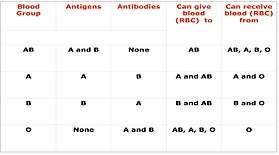Cross-matching
In transfusion medicine, cross-matching or crossmatching (part of series of steps in blood compatibility tests) is testing before a blood transfusion to determine if the donor's blood is compatible with the blood of an intended recipient. Cross-matching is also used to determine compatibility between a donor and recipient in organ transplantation. Compatibility is determined through matching of different blood group systems, the most important of which are the ABO and Rh system, and/or by directly testing for the presence of antibodies against the antigens in a sample of donor blood or other tissue.
| Cross-matching | |
|---|---|
 Compatibility testing concerning RBCs | |
| MeSH | D001788 |
Cross-matching is done by a certified laboratory technologist in a medical laboratory. It can be done electronically with a database if a patient has previously been tested, or serologically by physical testing if not. Simpler tests may be used to determine blood type only (known as blood typing), or to screen for antibodies only (see indirect Coombs test).
Types
Abbreviated cross-matching
Immediate-spin cross-matching (ISCM)
Immediate-spin cross-matching is an abbreviated form of cross-matching that is faster, less expensive but also less sensitive. It is an immediate test that combines the patient's serum and donor's red blood cells at room temperature. No agglutination indicates a negative test reaction, or compatible match. Indications for ISCM are dependent on the circumstances of the patient and it can be used in place of a full cross-match or performed as a preliminary test.
Electronic cross-matching
Electronic cross-matching is a computer-assisted analysis using data, from the donor unit (where a donor's blood is tested prior to donation) and testing done on blood samples from the intended recipient. This includes ABO/Rh typing of the unit and of the recipient, and an antibody screen of the recipient. Electronic cross-matching can only be used if a patient has a negative antibody screen, which means that they do not have any active red blood cell atypical antibodies, or they are below the detectable level of current testing methods. If all of the data entered is compatible, the computer will print a compatibility label stating that the unit is safe to transfuse.
Cross-matching falls into two categories:
- Major cross-match: Recipient serum is tested against donor packed cells to determine if the recipient has preformed antibodies against any antigens on the donor's cells. This is the required cross-match prior to release of a unit of packed cell from blood bank.
- Minor cross-match: Recipient red cells are tested against donor serum to detect donor antibodies directed against a patient's antigens. This is no longer required. It is assumed that the small amount of donor serum and antibodies left in a unit of packed cells will be diluted in a recipient.
Emergencies
As the complete cross-matching process takes approximately 1 hour, it is not always used in emergencies.
In the case of an emergency, a type-specific blood to which the recipient has no antibodies, can be requested. It is thought that this lifesaving measure is of more benefit than any risk of an antibody-mediated transfusion reaction. This type of blood has less risk of a serious transfusion reaction because it is both ABO compatible and Rhesus (Rh)-compatible.
Universal donor blood, which is both type O and Rh negative, can be given if the recipient's blood group is not known, as may happen in an emergency. Some institutions will only release O+ for male and O- blood for female patients. This serves two purposes. First, it preserves the lower stock of O- blood and secondly, this eliminates the risk of O- negative mothers forming anti-D (Rh) antibodies from exposure to O+ blood. Anti-D (Rh) can cross the placenta during pregnancy and attack an unborn child's RBCs if they are D (Rh) positive causing haemolytic disease of the newborn.
In an emergency, blood grouping can be done easily and quickly in 2 or 3 minutes in the laboratory on glass slides with appropriate reagents, by trained technical staff. This method depends on the presence or absence of agglutination (clumping of red blood cells), which can usually be visualized directly. Presence of agglutination indicates incompatibility. Occasionally a light microscope may be needed. If laboratory services are not available, the bedside card method of blood grouping may be used, where a drop of the intended recipients blood is added to dried reagents on a prepared card. This method may not be as reliable as laboratory methods, which are preferable.
References
External links
- Nobelprize.org Interactive online game for blood typing and transfusion (Flash Player 5 required)